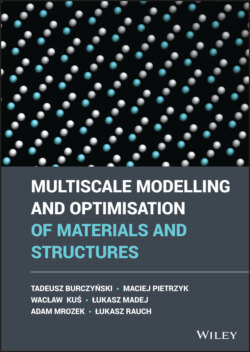Читать книгу Multiscale Modelling and Optimisation of Materials and Structures - Tadeusz Burczynski - Страница 13
1.1.2 Review of Problems Connected with Multiscale Modelling Techniques
ОглавлениеAs mentioned, in the field of metallic materials, several classifications of multiscale models exist. They depend on such issues as the character of coupling between the scales or methodology of data transformation between the scales. Coupling between the scales can be either strong or weak. Strong coupling combines a description of both (or more) scales into one equations system. In weak coupling, only some data are transferred between the subsequent scales. In the fine scale, the boundary or initial conditions can be developed based on coarse scale data (top‐down approach/downscaling), while data from the fine scale can be used as material properties or a material state in the coarse scale (bottom‐up approach/upscaling). Weakly coupled models have a relatively flexible structure and can be classified into top‐down and bottom‐up approaches.
The strength of coupling has some significant consequences. The strongly coupled models are usually faster and have a better mathematical and theoretical background. Usually, such models are solved with a single numerical method. However, phenomena in all scales must be described with consistent mathematical formulations (usually partial differential equations), which is rather hard or even not possible for some phenomena characterized, e.g.by stochastic behaviour. Moreover, the strongly coupled submodels cannot be separated, and their parts cannot be replaced with other submodels, which make their adaptation difficult. The weakly coupled models are more flexible, from both mathematical and numerical points of view, which makes their development and adaptation much easier. The coupling strength is linked with a methodology of data transfer between the scales.
Various classifications of the multiscale modelling methods were proposed having in mind all the aforementioned features of these techniques. Since this book is dedicated to simulations of materials processing methods, the multiscale models are classified into two groups: upscaling and concurrent approaches. In the upscaling class of methods, constitutive models at higher scales are constructed from observations and models at lower, more elementary scales [2]. By a sophisticated interaction between experimental observations at different scales and numerical solutions of constitutive models at increasingly larger scales, physically based models and their parameters can be derived at the macroscale. In this approach, it is natural that the microscale problem has to be solved at several locations in the macro‐model. For example, in the application of the concept of computational homogenization for each integration point of finite elements in the macroscale, the representative volume element (RVE) is considered in the microscale (Figure 1.2).
Figure 1.2 Illustration of computational homogenization concept.
Figure 1.3(a) Internal variable method as a precursor of upscaling and (b) the idea of the CAFE model.
Thus, classification of the multiscale problems with respect to the upscaling goals and the upscaling costs is needed, which is one of the book's objectives. The idea of upscaling has, in an intuitive manner, been used in engineering for decades. A commonly used approach based on a calculation of the flow stress in the FE model by a solution of the differential equation for the evolution of dislocation populations (Figure 1.3a) can be considered the precursor of upscaling.
Significant progress was made when more advanced discrete methods were used in the microscale; see Figure 1.3b, where the CAFE method (cellular automata finite element) is shown as an example. Now we witness further development of multiscale methods in computational science, which couple fine and coarse scales more systematically. A variety of models and methods is used in both microscale/nanoscale and macroscale. The models are generally different for the two scales, but solutions using the same model in the coarse and fine scales are common. FE2 method is a typical example of such an approach [3].
In concurrent multiscale computing, one strives to solve the problem simultaneously at several scales (in practice two‐scales) by an a priori decomposition of the computational domain. Large‐scale problems are solved, and local data (e.g., displacements) are used as boundary conditions for a more detailed part of the problem. The question of how the fine scale is coupled to the coarse scale is essential in this approach. The major difficulty in coupling occurs when different models describe fine scales and coarse scales, for example coupling FE to MD. In other words, the objective is to find a computationally inexpensive but still accurate approach to the decomposition problem. The terms ‘homogenization’ and ‘localization’ are commonly used for operations during data transfer. Again, this terminology is not well defined. Homogenization, in multiscale modelling, has two meanings. In the context of strongly coupled models, based on differential equations, it is understood as the asymptotic homogenization, the method of studying partial differential equations with rapidly oscillating coefficients. The in‐depth description of the homogenization and the averaging based on the perturbation theory, as well as their application to multiscale modelling, can be found e.g.in [12]. However, most authors use this term differently, describing it as ‘any method of transforming a heterogeneous field into a homogeneous one’. Weighted averaging is usually used; however, more advanced techniques are also present. In this book, we use the term homogenization in common understanding and asymptotic homogenization in the sense of the element of perturbation theory. Details on the multiscale classification and examples of its applications can be found in Chapter 5 of the book.
